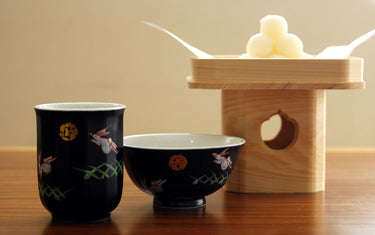In Japan, "Jugoya" has been held nationwide since ancient times as a custom to love the moon.
In ancient times, it was the aristocrats' pleasure to admire the moon reflected on the surface of the water or in a sake cup, but this custom eventually became popular among the general public and continues to this day.
In this issue, we would like to introduce a traditional Japanese event, Jugoya (Fifteen Nights).
The product we used:
What is Jugoya?
Jugoya is the night of August 15 on the lunar calendar, also known as Chushu-no-Meigetsu (Mid-Autumn Meigetsu).
According to the lunar calendar, the months of July through September are considered autumn, and Mid-Autumn is the day exactly in the middle of autumn (August 15 on the lunar calendar). Chushu-no-Meigetsu refers to the moon that appears on this day.
The lunar calendar was based on the phases of the moon, while the new calendar is based on the phases of the sun. Therefore, in the new calendar, Jugoya is generally celebrated from mid-September to early October.
By the way, Jugoya in 2022 will be on September 10.
Origin of Jugoya

In Japan, there has been a custom of moon-loving since ancient times. It is said that the value of viewing the moon as sacred already existed in the Jomon period (710-794), and around 869, the custom of the fifteenth night was introduced from China and became popular among the Japanese aristocracy.
As Jugoya spread among the common people, it became an event to celebrate and give thanks for a bountiful harvest because it coincided with the time of year when crops were harvested. Jugoya is a harvest festival for the Japanese.
What to Do on Jugoya

On Jugoya, it is common to make wishes, make offerings, and admire the moon.
The most classic style is to decorate with silver grass and make offerings of Tsukimi dango (dumplings for moon viewing) and harvested crops, but offerings have changed from region to region and from era to era. Recently, it is not uncommon to see simple styles decorated with Mitarashi dumplings or Daifuku (rice cake stuffed with sweet bean paste).
By the way, Tsukimi dango is a pyramid-shaped pile of 15 round dumplings, said to derive from the Chinese confectionery Geppei (moon cake).
Jugoya and the Rabbit
In Japan, the moon and the rabbit are closely related. In Japan, it has long been said that a rabbit is pounding rice cakes on the moon. This is because the shape of craters visible on the lunar surface is interpreted as a rabbit pounding rice cakes.
The relationship between the moon and rabbits is said to derive from the legend of the moon rabbit in Buddhist legends.
The legend of the moon rabbit features a rabbit, a fox, and a monkey. Each of the three would prepare food to help the hungry old man, but the rabbit, no matter how hard he tried, could not catch any food. After much consideration, the rabbit jumped into the fire himself, saying, "Please eat me". God, who was transformed into an old man, took pity on such a rabbit and resurrected him on the moon to serve as an example to follow.
Jugoya is a day for people to reflect on themselves, remembering the devotion and benevolence of such rabbits.
A Wide Variety of Designs Featuring Tsukimi Rabbits

Globalkitchen Japan offers a selection of rabbit-themed items appropriate for Jugoya, including rabbit designs from Kutani ware, a traditional Japanese craft with a 360-year history.
In addition to enjoying Jugoya, there are a wide variety of designs based on the dedication moon-viewing rabbit. It is a perfect gift to convey devotion and philanthropy. We hope you will enjoy the beautiful designs and shapes of each piece, which are individually handcrafted by craftmen.
Let's enjoy traditional Japanese culture on Jugoya!

Jugoya" is a Japanese traditional culture to enjoy the beautiful autumn moon.
On Jugoya, how about decorating silver grass and making offerings, and looking at the moon while sharing a drink with those close to you? It will be a good opportunity to reflect on your daily routine and yourself, such as gratitude for crops and nature, and love and trust with your loved ones. You may understand why Jugoya has been an important custom for the Japanese people since ancient times.















